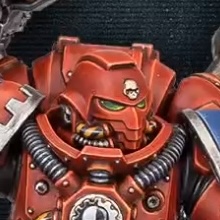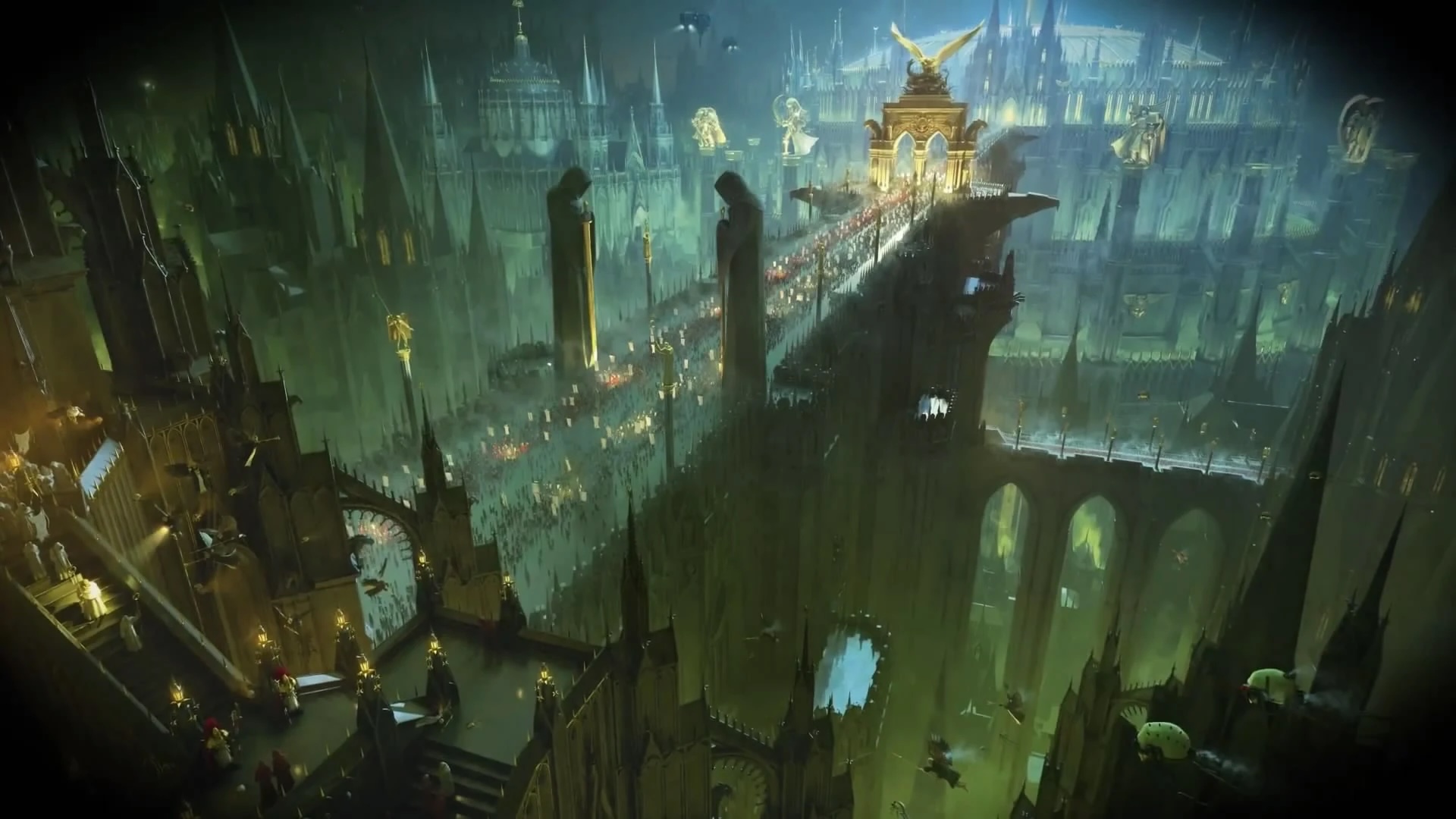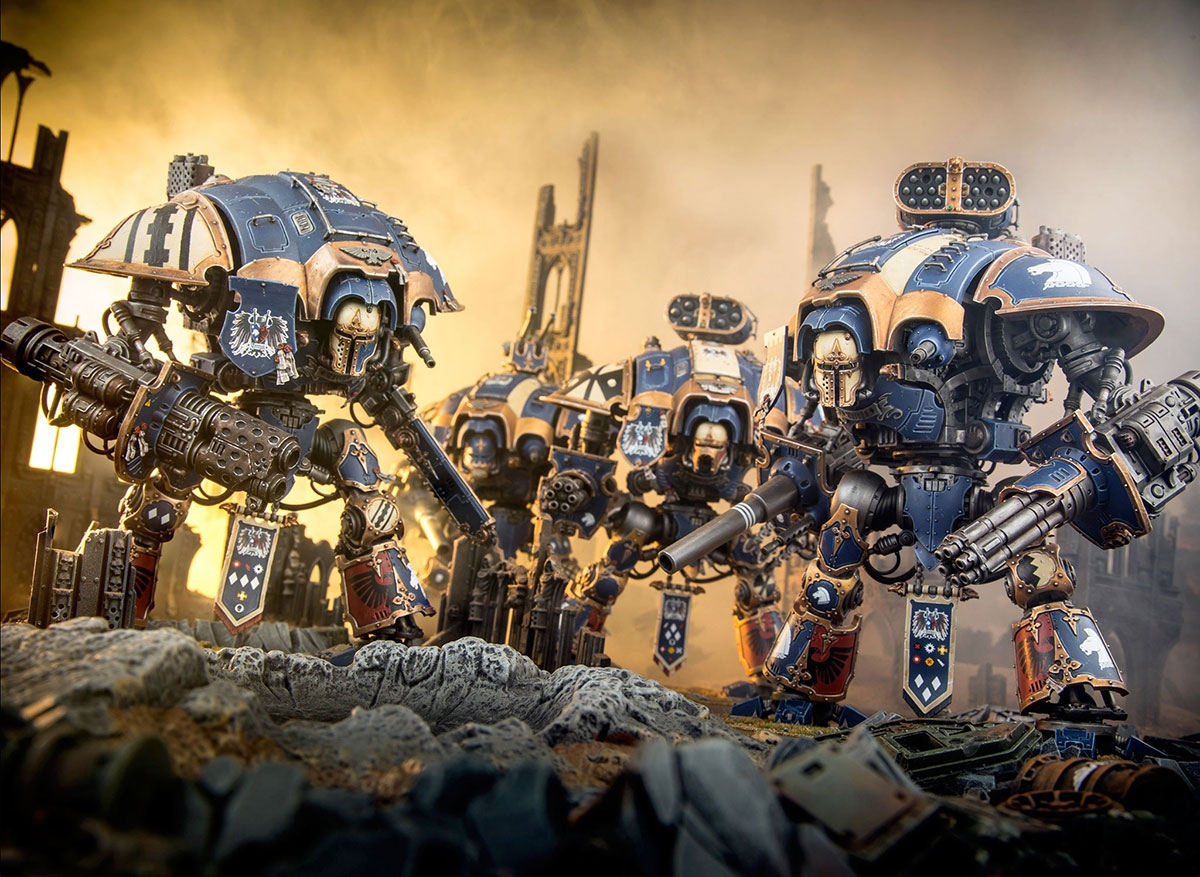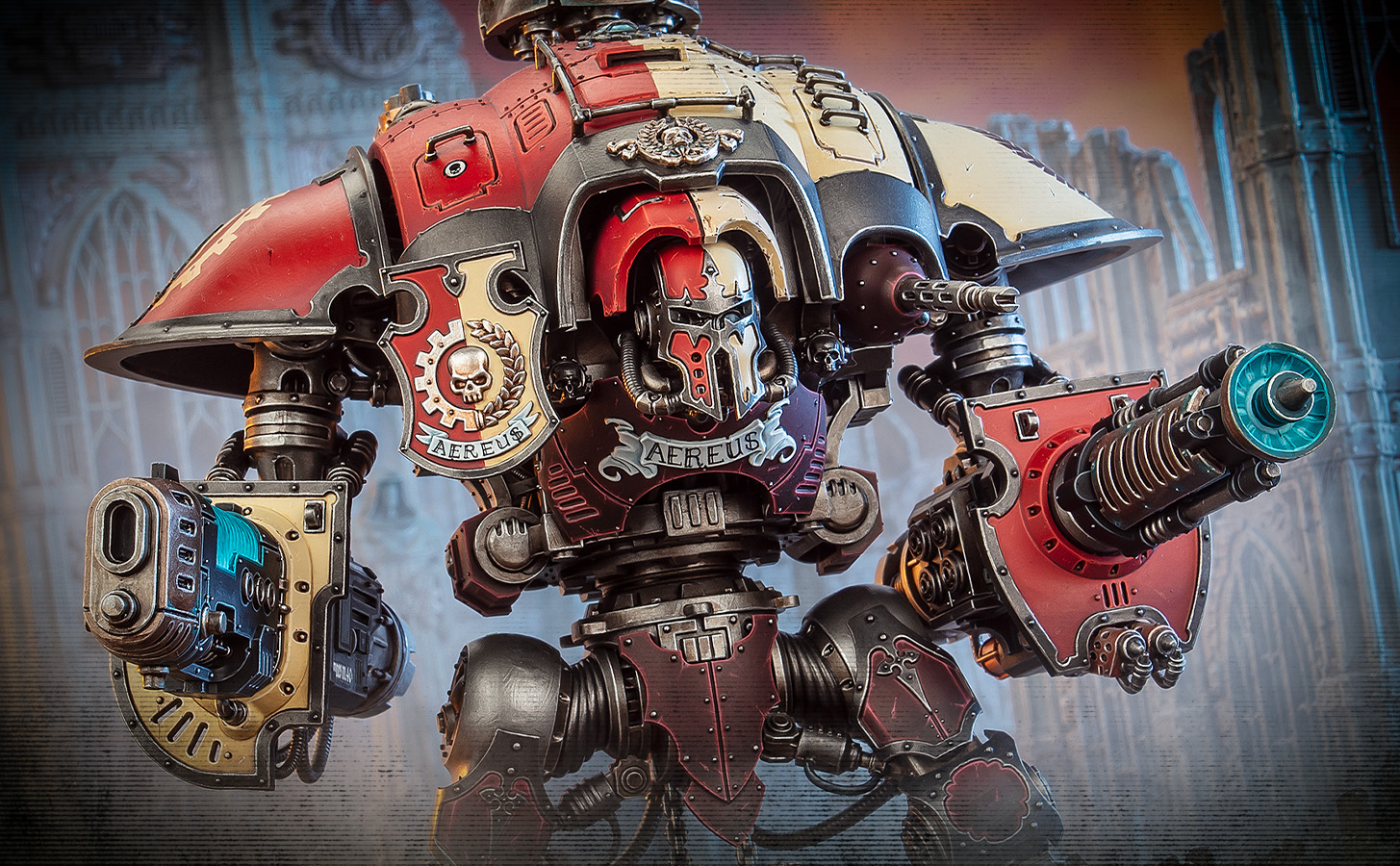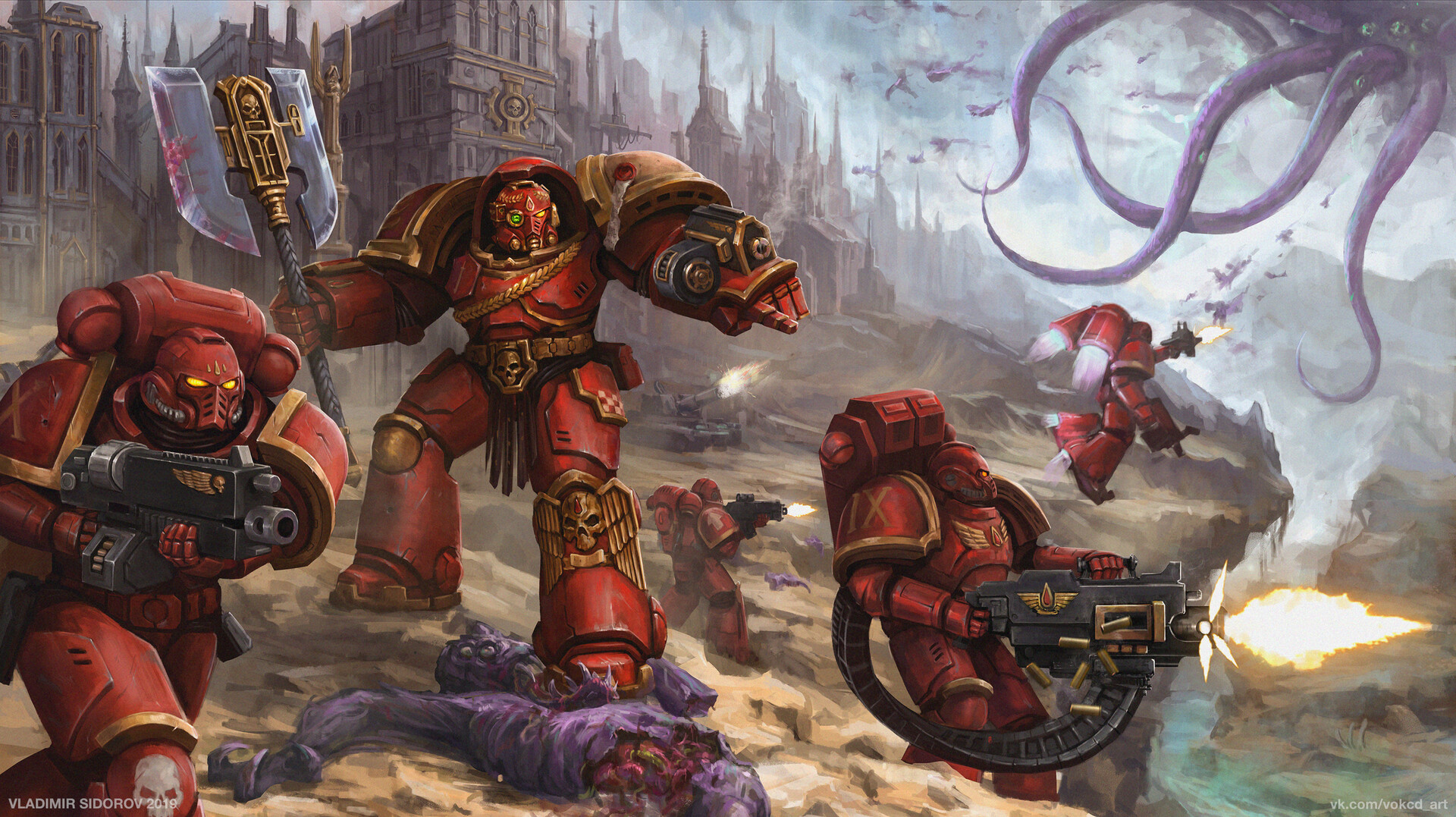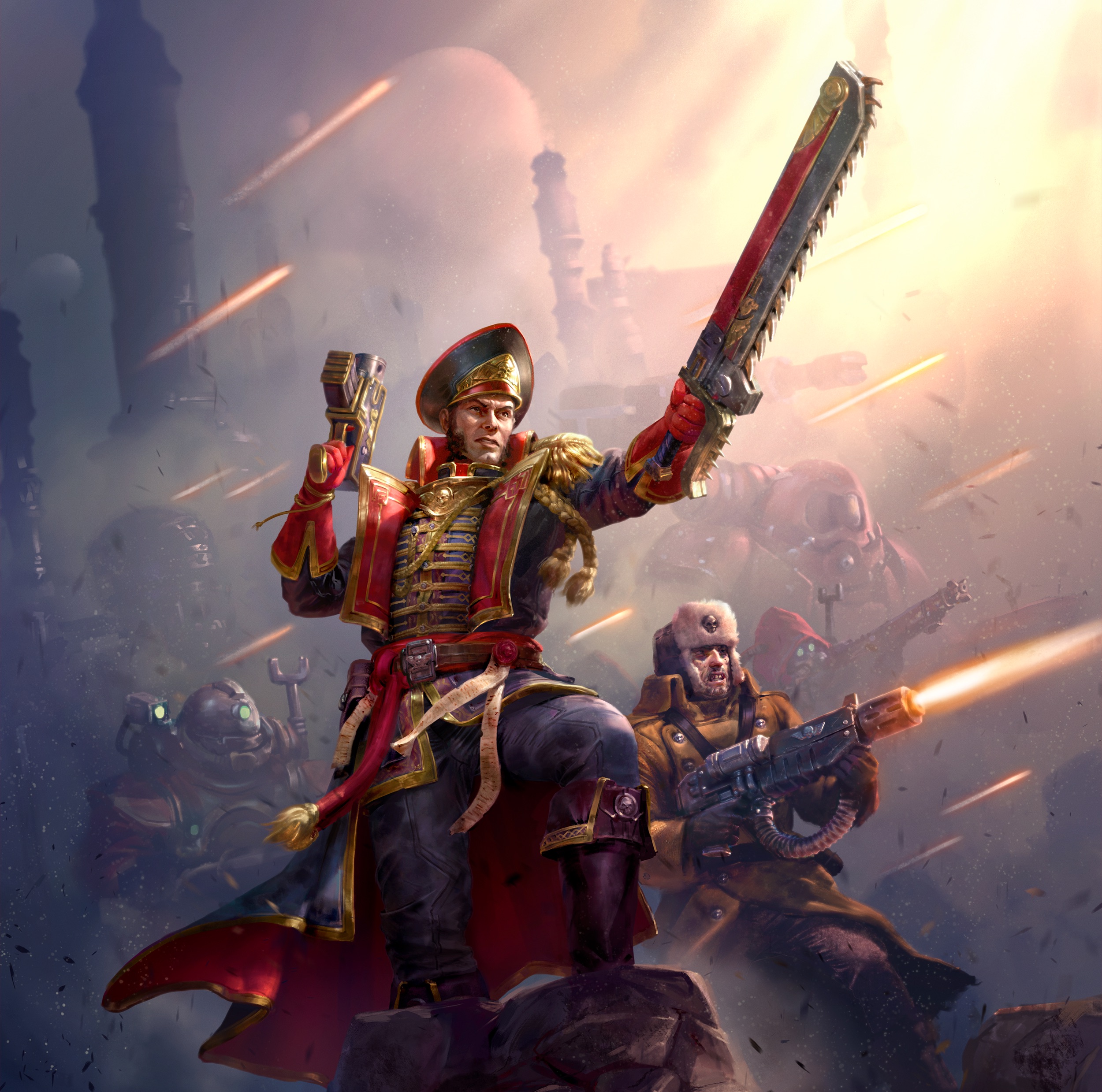Origins and Historical Development
The Collegia Titanica is the ancient division of the Mechanicum (now Adeptus Mechanicus) that commands the Imperium’s Titans – colossal war machines revered as god-engines. Their origin dates back to the Dark Age of Technology and Age of Strife, when humanity first forged these towering machines. On Mars, the Mechanicum created the very first Titans amidst a terrible war against the Cy-Carnivora techno-heretics. These early Titan battle groups – known as Titan Orders – proved decisive in purging Mars of the heretical scourge, establishing the Titan Legions as the defenders of Forge Worlds in the ensuing Age of Strife. Each Titan, even then, was more than a weapon: it was a symbol of the Machine God’s wrath incarnate.
With the coming of the Emperor and the alliance of Mars and Terra (formalized by the Treaty of Olympus), the Collegia Titanica joined the Great Crusade. Titan Legions marched alongside the Legiones Astartes and Imperial Army to conquer new worlds for the nascent Imperium. The Mechanicum established Forge Worlds across the galaxy, and many of these became home to new Titan Legions, each developing its own colors, honors, and revered Titans. During the galaxy-spanning Crusade, mighty Titans such as the ancient Warlords brought thousands of worlds to compliance, some of these god-engines themselves dating back to the lost glories of the Dark Age. The Horus Heresy shattered this unity – nearly half the Titan Legions turned traitor along with Horus. In the catastrophic civil war that followed, Traitor Titan Legions (Titanicus Traitoris) clashed with Loyalist engines on hundreds of worlds, including the siege of the Imperial Palace on Terra. In that final battle, Titans on both sides reaped a terrible toll; the traitor Legio Mortis (the Death’s Heads) led by the infamous Warlord Dies Irae spearheaded Horus’s assault, opposed by Loyalist Titans such as Legio Ignatum’s venerable Fire Wasps. In the end, the traitor god-machines were driven into the Eye of Terror alongside the rest of Horus’s fallen hosts, their names accursed in Imperial records.
In the 41st Millennium, the Collegia Titanica endures as a vital yet rare instrument of war. Rebuilt after the Heresy, the Titan Legions have fought in countless wars – from the grand campaigns of the early Imperium to the desperate battles of the present Indomitus Era. Titans are so valuable that they are deployed only to the most critical warzones, where their scale and firepower can turn the tide. They strode to war alongside Lord Solar Macharius during the Macharian Crusade (392–399.M41), bringing awe and terror as they helped conquer a thousand worlds. In the current era of the Great Rift, Titan maniples march in the Indomitus Crusade to reclaim worlds cut off by Chaos. For example, Battle Group Haephestus of Fleet Tertius included Legio Invigilata Titans – three full maniples of god-engines deployed as part of Roboute Guilliman’s crusade. Across the millennia, the Collegia Titanica’s history has been written in apocalyptic battles and planet-shattering engagements, securing its place in the grim lore of the Imperium.
Organization of the Titan Legions
The Titan Legions (also called Titan Orders or Legios) are the principal fighting forces of the Collegia Titanica. Each Legion is a proud and largely autonomous unit, typically based on a specific Forge World which serves as its armory and home. A Titan Legion is a formidable army in its own right – comprising not only the Titans themselves but also support personnel, auxilia troops, and forge adepts. Legion size varies, but a typical Titan Legion fields around 50 operational Titans. Losses are irreplaceable in the short term; constructing a new Titan is so arduous that battle losses can take centuries to make good. For this reason, every god-engine lost is mourned, and every deployment is weighed carefully. The common Titan classes found in a Legion are often the ancient, robust designs like the Warlord Battle Titan, while the towering Imperator-class Emperor Titans are exceedingly rare relics on the battlefield.
Every Legion is led by a senior Princeps – often bearing titles like Princeps Majoris or even Grand Master – who commands the entire order. Under this leader, the Legion is subdivided into multiple maniples, each a tactical group of about five Titans commanded by a veteran Princeps Senioris. A common formation is the Axiom Maniple, composed of a balanced mix of Titans: typically one Warlord as the lead engine, supported by two Reaver Battle Titans and flanked by two Warhound Scout Titans. This structure allows the maniple to operate as a self-contained battle unit, combining the Warlord’s firepower, the Reavers’ versatility, and the Warhounds’ speed. Other maniple configurations exist (such as the all-heavy “Dominatus” or swift “Venator” groupings), but the Axiom pattern is prized for its tactical flexibility. The Princeps Senioris of a maniple is given discretion to execute the High Princeps’ orders on the field, and his experience and personality often shape how the maniple fights. In major engagements, multiple maniples (sometimes an entire Legion’s strength) will fight in concert under a unified command, referred to as a Battlegroup. Senior Tech-priests of the Legion (often bearing the title Magos) accompany these forces, ensuring the machine-spirits are appeased and occasionally overruling tactical decisions if the survival of irreplaceable engines is at stake.
Besides the Titans, each Legion maintains specialist infantry known as the Secutarii – the Titan Guard. These are cybernetic Skitarii troops tasked with protecting the god-engines and mopping up enemy survivors in a Titan’s wake. Armed with arcane weapons, Secutarii form a defensive screen against swarming infantry or aerial threats that might endanger a Titan’s vulnerable joints and reactor. The Legion’s support structure also includes myriad tech-adepts, logisticians, and serfs who handle everything from engine maintenance to communications. The Collegia Titanica itself is divided into several Divisions (such as the Divisio Militaris for battle operations, Divisio Investigatus for experimental tech, etc.), but by far the most important to Imperial war efforts is the Divisio Militaris – the Titan Legions proper. In some rare cases, a Titan Legion can be called to special duties: the Divisio Mandati Titans, for instance, are Emperor-class Titans assigned to bring worlds into Imperial Compliance as diplomatic enforcers, traveling on great temple-ships and carrying representatives of the Imperium’s authority. Whether on a crusade of conquest or standing guard over a vulnerable sector, the internal hierarchy and support of a Titan Legion ensure that these god-machines can wage war as a coordinated, devastating force.
Princeps, Crew, and the Bond with the Machine
Operating a Titan is as much a spiritual ordeal as a military task. At the heart of each god-engine stands the Princeps, the Titan’s commander, who literally melds their mind with the Titan’s machine-spirit. Seated upon a command throne (often immersed in an amniotic fluid tank in larger Titans), the Princeps plugs into a Mind Impulse Unit (MIU) that links their nervous system to the Titan. Through this techno-arcane interface, the Princeps controls the Titan as though it were their own body – every ponderous stride, every thunderous weapon discharge is an extension of the Princeps’ will. The connection is a two-way bond: the Titan’s semi-sentient anima (machine-spirit) presses back into the Princeps’s mind, merging personalities. Ancient Titans, having fought countless battles and been bonded to many Princeps over centuries, carry particularly potent spirits. These machine-minds can be wrathful, even willful, and an unprepared Princeps might be mentally overwhelmed by the Titan’s persona. Only those of exceptional strength of mind and soul can master a god-engine; lesser individuals would be driven insane by the psychic feedback.
Assisting the Princeps is a small cadre of Moderati (singular Moderatus), who serve as the Titan’s subordinate officers and system operators. Each Moderatus is responsible for a specific aspect of the Titan’s operations – one may steer the Titan’s locomotion, another monitor and fire certain weapon systems, another manage augury sensors and communications. In the cramped, armored cockpit (the “head” of the Titan), several Moderati sit at control stations around the Princeps. Additional Moderati can be located in the Titan’s massive frame near what they control: for example, gun moderati may be stationed in the Titan’s arms or carapace to oversee the loading and aiming of the immense weapons batteries. These crew members all share a lesser form of MIU link called the Manifold, which networks them to the Princeps and the machine-spirit, creating a gestalt consciousness across the crew. Over long campaigns, the Princeps and moderati develop a deep familial bond – they quite literally feel each other’s pain and triumphs through the Titan’s neural links. It’s said that a good Titan crew moves and fights with one mind, utterly unified with their god-machine.
Deep in the Titan’s hull, tended by incense-wreathed adepts, roars the plasma reactor that powers the engine. Here, one or more Tech-priests Enginseers and their Servitors maintain the Titan’s mechanical heart. The Tech-priests constantly monitor the reactor’s spirit, coolant systems, and massive limb motivators, chanting binharic prayers to placate the machine’s temper. Dozens of cybernetic servitors – lobotomized human-machine drones – are hard-wired into various subsystems. Servitors load ammunition, regulate shield outputs, manage cooling, and perform other brute-force tasks under the Tech-priest’s guidance. A smaller Titan like a Warhound might have only a Princeps, two Moderati, and a handful of tech-menials on board. A mighty Warlord could have a dozen crew, and an Emperor-class Titan even more, including multiple Tech-priests and an entire choir of servitors hard-wired throughout the towering chassis. All crew members are surgically augmented for their roles, and many are trained from childhood for this destiny.
The connection between Titan and Princeps is both a source of power and a terrible risk. When the Titan is struck by enemy fire, the Princeps feels the pain as if their own flesh were hit. Hull breaches and critical damage can send neurofeedback that sears the Princeps’s nerves, often causing permanent injuries called “God-machine Stigmata” – burn scars and nerve damage matching the wounds of their Titan. If a Titan is slain in battle with its reactors overloading, the resulting psychic shock through the MIU is almost certainly fatal to the Princeps. Many Princeps have gone down with their Titans, their minds literally burned out in communion with their dying god-engine. Those who survive long enough may find it hard to live outside of this union; veteran Princeps often become impatient, even depressed, when not bonded to their Titan’s glorious strength. In some recorded cases, Princeps of ancient Titans have forsworn leaving their command throne at all, preferring to remain permanently linked in the hangar rather than endure separation. Such is the price of wielding the might of a god-machine – a Titan’s crew surrenders part of their humanity to merge with cold metal and holy circuitry. Together, Princeps and crew become the animating soul of the Titan, and in battle their unity can annihilate armies.
Imperial Titan Classes and Battle Roles
Imperial Titans range from relatively agile scout walkers to colossal siege engines the size of cathedrals. The Collegia Titanica fields several classes of Battle Titan, each designed for a distinct battlefield role and laden with destructive weaponry. All Titans are protected by layers of adamantium armor and enveloped in energy shields called Void Shields, which can absorb tremendous firepower. Below is an overview of the major Titan classes in use by the Imperium:
• Warhound Scout Titan: The smallest and fastest class of Imperial Titan deployed in the Titan Legions. Warhounds stand about 17 meters tall and have a distinctly canine, hunched appearance with reverse-jointed legs built for speed. As scouts and flankers, Warhounds are comparatively lightly armored, but they are still formidable to any conventional vehicle – their typical armament includes twin turbo-laser destructors, plasma blastguns, or massive Vulcan mega-bolters that can rip apart super-heavy tanks with ease. Warhounds usually hunt in pairs known as packs. In fact, after the Horus Heresy, the Imperium forbade Warhounds from operating in larger squads due to the traitors’ wanton use of “packs” of 10+ Warhounds to terrorize civilian populations during the Siege of Terra. This gruesome legacy means two Warhounds acting in concert are trusted to range ahead of the main Titan battle group, using speed and surprise to outmaneuver the enemy. On the battlefield, a Warhound pack will dart around larger Titans or terrain, seeking to flank enemy armor or ambush lighter targets. Their void shields are weaker and cannot withstand sustained fire, so Warhounds rely on constant movement, hunting like steel predators. In a Titan engagement, Warhounds serve as the swift claws of the Legion – scouting enemy positions, chasing down fleeing foes, or harrying the flanks of a besieged fortress.
• Reaver Battle Titan: A true Battle Titan, the Reaver is a medium-class Titan (~25 meters tall) that balances firepower, armor, and speed. Heavier than a Warhound and more maneuverable than a Warlord, Reavers often act as line support units in Titan Legions. They carry a mix of weapons – a Reaver has two arm mounts (capable of wielding many of the same titanic weapons as a Warlord, like gatling blasters or volcano cannons) and a carapace mount often fitted with rocket pods or additional lasers. This versatile armament lets Reavers engage a variety of targets: bombarding fortifications with rockets, shredding enemy tanks or Knights with gatling fire, or even dueling other Titans. Notably, Reavers can equip massive close-combat weapons (such as a power fist or chainblade), making them lethal in Titan-on-Titan melee. Their design is actually older than the Warlord’s, and the Mechanicus fears that Reaver production is dwindling as some STC patterns have been lost. As a result, Reavers are precious assets. Tactically, a Reaver often provides mid-range fire support or spearheads assaults alongside Warlords. They have an unusual reactor placement – on their back – granting extra resilience to frontal hits. However, in dense city fights the Reaver’s high profile and rear reactor can be a disadvantage. Many Princeps thus keep their Reavers at medium range, raining death from a relatively safer distance. In open-field battles, a pack of Reaver Titans unleashing full broadsides is a sight to behold – and often the last thing seen by the enemies of Mankind.
• Warlord Battle Titan: The Warlord is the quintessential Titan of the Legions – a main battle Titan that stands approximately 30–33 meters tall (about a 10-story building). Warlords are the most common class of Titan in active service, considered the workhorses of the Titan Legions. In sheer power and durability, a Warlord outclasses almost any other engine of war. Its frame bristles with four primary weapon hardpoints – two arm mounts and two shoulder (carapace) mounts – usually fitted with the heaviest Titan-grade weapons. Common loadouts include Volcano cannons (essentially enormous laser cannons capable of melting armored companies in a shot), Plasma annihilators, Gatling blasters, and laser blasters on the carapace, among others. A Warlord also carries multiple secondary weapons: for example, the Mars-Alpha Pattern Warlord has turreted defense batteries like Mauler bolt-cannons and lascannons for close defense. With multiple layers of ablative armor and up to six void shield generators guarding it, a Warlord can withstand sustained volleys that would obliterate lesser machines. In battle, Warlord Titans stride at the forefront of Titan assaults or anchor the defense of critical objectives. They are relatively slow-moving but inexorable. It is said a single Warlord’s salvo can level an entire city, and in duels, a Warlord will almost always triumph over smaller Reavers or Warhounds through brute strength. There are specialized Warlord variants as well, such as the rare Psi-Titans of the Ordo Sinister that mount psychic weaponry to combat daemonic foes. But in all forms, the Warlord is revered as a titan among Titans. Each of these god-engines is ancient and celebrated; many have honor rolls of centuries of service. Their Princeps and crews are among the most honored warriors of the Collegia Titanica. To see a Warlord Titan march to war – banners flying, void shields aglow, chanting priests anointing its adamantine hull – is to witness the wrath of the Omnissiah made manifest.
• Emperor-Class Titan (Imperator & Warmonger): The Emperor Titans are the largest land-based war machines of the Imperium – walking mountains of armor and firepower. Imperator-class and Warmonger-class Titans are subtypes of the Emperor Titan category. Both are massive (often over 100 meters tall, with some accounts up to ~150m) and serve as mobile fortresses. The Imperator is a general-purpose assault Titan, while the Warmonger is configured for long-range fire support with advanced targeting arrays. In either case, Emperor-class Titans are extremely rare – the Adeptus Mechanicus no longer fully knows how to build these god-engines anew, and only a few exist, each a relic of millennia. An Emperor Titan carries an entire battle cathedral on its back: a fortified castle-like structure complete with spires, battlements, and stained-glass windows. Within this edifice are devotional shrines and command sanctums; the crew and attending priests literally worship within their Titan between battles. Emperor Titans are armed with an overwhelming arsenal. For example, an Imperator might mount two arm weapons such as a Plasma Annihilator and a Hellstorm Cannon (gigantic energy and thermal weapons), along with multiple turrets of turbo-laser destructors, battle cannons, and missile launchers on the carapace and castle towers. Unlike smaller Titans, Emperor-class designs do not engage in melee – all their weaponry is ranged, focused on total firepower supremacy. They can obliterate armies and level hive-cities with barrages that shake the heavens. Their legs are so massive that they contain troop barracks; an Imperator can transport a full company of Skitarii or Imperial Guardsmen inside its leg-bays to deploy for close defense. In battle, an Emperor Titan is often a command centerpiece – a single Engine that can dictate the course of a war. During the Horus Heresy’s Battle of Molech, for instance, the loyalists deployed the Imperator-class Titan Paragon of Terra, whose intervention blunted the traitors’ onslaught. The appearance of such a god-engine on the field has an incalculable effect on morale: to Imperial forces it is as if the God-Emperor himself towers in judgment, while to the enemy it is the incarnation of doom. The Adeptus Mechanicus holds Emperor Titans to be sacred avatars of the Machine God. They are literally called Dies Irae (“Day of Wrath”) or Gloria in excelsis and other such exalted names, treated as shrine-temples when not at war. Only the most distinguished Princeps in the Titan Legions can be entrusted with one of these divine engines. On the rare occasions an Emperor Titan walks to war, the ground quakes under its feet and enemies quail in its shadow – for the God-Machine has come, and doom follows.
The Forge of Titans and the Cult of the Machine God
A Titan is not built – it is born in the fiery heart of a Forge World, in rites that are half engineering and half religious ritual. The Adeptus Mechanicus carefully maintains the STC designs and forges necessary to construct Titans, but even for them it is a monumental undertaking. The fabrication of a single Battle Titan (like a Warlord) can take decades of labor by Magi, artisans, and servitors. Each component – from the kilometer of circuitry in the MIU cortex to the meter-thick armor plates – is painstakingly crafted, consecrated, and assembled. New Titans are seldom seen in the Imperium; most Titans serving in the Legions are ancient, revered machines that have been rebuilt and repaired countless times. In fact, the Mechanicus has lost the capability to manufacture Emperor-class Titans entirely, which is why Imperators and Warmongers present are cherished relics, handed down from past ages. Even more common classes are slow to replenish. As noted, catastrophic Titan losses in battle may not be replaced for centuries. When a forge world does undertake to create a new Titan, it is as much a religious ceremony as a production project – overseen by the Fabricator-General or a High Magos, accompanied by choirs of tech-priests chanting the Canticles of Construction, and perfused with sacred oils and incenses to placate the machine spirit that will inhabit the god-engine.
The Cult Mechanicus views the Titans as holy instruments of the Omnissiah (the Machine God). Each Titan is effectively a walking cathedral. Tech-priests assigned to a Titan Legion perform rituals of awakening each time the machine’s spirit is stirred. Before battle, incantations are recited, runes of protection are inscribed on giant plating, and the Rite of Pacification is enacted to keep the Titan’s machine-spirit cooperative. The crew too engages in liturgies – the Princeps will intone prayers like “Steel be my body, fire be my blood” as they connect to the MIU, becoming one with the Omnissiah’s wrath. Maintenance itself is a form of worship: when a Titan returns to its forge-temple, teams of enginseers swarm over it, chanting litanies of repair. They re-sanctify its weapons after every firing and offer up thanks to its spirit for its performance. Battlescars are often kept as honored “relics” on the Titan’s hull – patched but not fully scrubbed away, bearing testament to great battles survived. Some Titans even carry massive banners or scrolls listing their centuries of victories and the names of fallen Princeps who served as their avatar. It is little wonder that the Legio crews develop something akin to a cult around their own Engine. Many Princeps call their Titan “my god” without irony, and see themselves as merely the vessel through which the Titan’s will (and by extension, the Machine God’s will) is done.
The forging of a Titan doesn’t end with its construction – it continues as a legacy. When a Titan is badly damaged, its remains are recovered at all costs, because its machine-spirit can be transplanted into a rebuilt chassis if needed, or its parts used to bolster other Titans. A Titan that has served for millennia might literally contain components (circuits, engine cores, weapon housings) that are thousands of years old, handed down from predecessor to successor. This deep time perspective adds to the awe the Mechanicus has for them. To the tech-priests, a functional Titan is a link to humanity’s mythical Golden Age, a living relic that embodies knowledge that might otherwise have been lost. Accordingly, Titans are accorded the status of demigods in the Cult Mechanicus. The largest of them, the Emperor Titans, are explicitly described as “avatars of the Machine God in the mortal world”. Even smaller classes are often referred to as “god-engines” by their devotees. Such language isn’t mere poetry – it reflects the deeply-held belief that the Machine God’s spirit inhabits these iron giants, and through them, the Omnissiah smites the enemies of Mankind.
When a Titan goes to war, priests from the Legion’s Ordo Reductor or Lexmechanics will accompany it, swinging incense burners and chanting binary prayers to sanctify the battlefield. As the Titan’s massive footfalls shake the ground, nearby Skitarii and Guardsmen often kneel or bow, making the sign of the aquila or the cog. They know that the god-machine fights for them, and in the superstitious mind of the common soldier, that confers a divine sanction to the battle. It’s not uncommon for entire regiments to fight harder and hold longer simply because a Titan is at their side – or conversely, to fall into despair when a friendly Titan is finally brought down by the foe. The death of a Titan is marked by the Mechanicus with the same gravity as the death of a saint; a funerary ritual is held, and if possible the remains are retrieved to be entombed or recycled for the Legion’s future use. To those in the Imperium, all of this is normal – it is part of the grimdark reality that technology and faith are inseparable. A Titan is a machine, a weapon, a walking tank – but it is also a totem of the Imperial Creed’s wrath (the God-Emperor is often invoked alongside the Machine God in battle-invocations), and a literal altar of war. The Collegia Titanica embodies this duality: they wage war with calculated engine power, yet exalt the Titan as a sacred being. In the Imperium’s eyes, a Warlord Titan striding to battle is nothing less than a steel deity, and its guns are the thunder of the gods.
Notable Titan Battles and Campaigns
Throughout Imperial history, the Titan Legions have been instrumental in some of humanity’s most legendary conflicts. Below are a few renowned battles where Titans shaped the outcome:
• Battle of Molech (Horus Heresy, 006.M31): Fought on the Knight World of Molech, this massive engagement saw multiple Titan Legions on both sides. Three Loyalist Titan Legions (along with Knight Households and Imperial Army armies) defended Molech against Warmaster Horus’s invading forces, which included no fewer than four Traitor Titan Legions. The battle was apocalyptic. Entire cities were obliterated by orbital strikes and Titan weaponry. In one notable clash, traitor Titans of Legios Crucius, Vulpa, and Vulcanum overran a loyalist stronghold at the plateau city of Leosta, their combined god-engines leveling the defenses. The Loyalist Legio Fortidus sacrificed its last Titans in a desperate holding action to evacuate civilians. At the height of the battle, the Loyalists unleashed an Imperator-class Titan, Paragon of Terra, which single-handedly stemmed the tide and prevented an immediate Horus victory. Its colossal firepower obliterated traitor hosts and bought precious time, becoming a legend among the Collegia Titanica. Ultimately, Molech fell to Horus, but the battle proved the fury of Titan-on-Titan warfare, and “Molech” remains a hallowed name in Titan lore.
• Siege of Terra (Horus Heresy, 014.M31): The final battle of the Heresy on Holy Terra involved Titan combat on an unprecedented scale. Traitor Titan Legions – foremost among them Legio Mortis – marched under Horus’s banner to tear down the Imperial Palace’s defenses. They were met by Loyalist Titans of Legio Ignatum (the famed “Fire Wasps”) and others, standing astride the Palace walls. Over several solar days of brutal fighting, Titans dueled amid the broken spires of Earth’s mightiest city. The Traitors even landed new Warmaster heavy Titans to reinforce their assault, countered by the last reserves of the Loyalists. In a celebrated moment, the Blood Angels Primarch Sanguinius personally slew a Chaos-corrupted Titan of Legio Vulpa – leaping onto the engine and spearing its corrupted heart – causing three accompanying Warhounds to panic and flee. Yet for all such heroics, the Titans on both sides exacted a dreadful toll. The Dies Irae, mightiest Warlord of Legio Mortis, led a breach that even the Imperial Fists and Legio Ignatum struggled to contain. At one breach, fifty Loyalist Titans made a last stand against a swarm of traitor engines and daemon-infested war machines. By the end of the siege, many Titans lay as burning hulks amid the ruins of the Palace. The Loyalists held out just long enough for Horus to be defeated in orbit by the Emperor. The Siege of Terra cemented the Titan Legions’ reputation – the colossal husks of wrecked Warlords and an Imperator around the Palace were said to stand for centuries as grim memorials to that final battle of gods.
• Macharian Crusade (392–399.M41): The grand Imperial Crusade led by Lord Solar Macharius to conquer the far reaches of Segmentum Pacificus saw significant involvement from the Collegia Titanica. Macharius’s forces included several Titan Legions seconded by the Adeptus Mechanicus. These god-engines proved invaluable in sieging heavily-defended worlds that Macharius’s rapid light forces alone couldn’t crack. On Karsk IV, for instance, a rebelling fortress-city shielded by void shields yielded only after Macharius deployed a pair of Warlord Titans that pummeled the shields day and night, eventually shattering the defenses for the infantry to storm in. The sight of Titans striding in formation across the dusty plains of frontier worlds helped cow many systems into surrender without a fight – after all, resistance seemed futile when a 1,000-ton war machine demanded fealty. By the Crusade’s end, nearly a thousand worlds had been added to the Imperium, in part thanks to the psychological and military impact of the Titan Legions. The Macharian Crusade’s swift victories earned Macharius comparisons to the Great Crusade of old, and the Titans at his side were lauded in dozens of expedition chronicles. Later, during the fragmentation of Macharius’s conquered territories (the Macharian Heresy), Titan detachments were used again to put down aspiring warlords, proving that even in civil strife the presence of a Titan is often the ultimate argument.
• Battles of the Indomitus Era (M42): In the wake of the Cicatrix Maledictum (Great Rift) tearing the galaxy in half, the Imperium’s Indomitus Crusade (led by the returned Primarch Roboute Guilliman) once again called upon the Titan Legions. With daemon incursions and heretic forces besieging countless worlds, only the god-engines could bring the Emperor’s justice to certain war zones. One noted campaign saw Legio Invigilata (veterans of the Gothic War and Third War for Armageddon) deployed to reclaim forge world Gantz from a Demonic host. Three Warlord Titans of Invigilata walked in step, their guns purging the daemon-spawn in a night of fire – the survivors of Gantz to this day worship those Titans as divine saviors. In Fleet Tertius’s Battle Group Haephestus of the Indomitus Crusade, records show three maniples of Titans were active, including venerable engines that had fought Hive Fleet Leviathan decades earlier. These Titans were instrumental in the Cleansing of Drennox, where they obliterated an entire continent infested by heretical cults and dark xeno machinery. In the Era Indomitus, war zones are often chaotic and riven with Warp storms, but where a Titan can be transported and deployed, it serves as a towering pillar of Imperial supremacy. Even the emergence of new threats like the Necron world-engines or ork Stompa hordes finds an answer in the Titan Legions – the god-machines continue to be the Emperor’s fist, bringing hope to the Imperium’s beleaguered defenders and despair to its foes.
Scale, Power, and the Cult of the God-Machine
In the grim darkness of the far future, the Imperial Titan is more than a war machine – it is a walking myth, a deity of battle. To witness a Titan Legion in full stride is to glimpse the scale of the Imperium’s power. Titans tower over the battlefield, each one capable of reshaping the landscape with void-shattering weaponry. A single Titan can dominate a warzone; a full maniple can crush a rebellion or halt an alien invasion that would overwhelm entire Imperial armies. This awe-inspiring power is matched by the quasi-religious reverence in which these engines are held. Every Titan is given a name and a legacy. They are the God-Machines of the Imperium, worshipped by their crews and feared by the enemy. On countless worlds, terrified foes have looked up at the sound of pealing war-horns to see a Warlord Titan emerging from acrid smoke, sunlight gleaming off its baroque armor – a sight that breaks enemy morale as surely as its guns break their bodies. The Collegia Titanica’s history is a chronicle of such moments: of god-engines striding in the ashes of battle, of fortress-cities toppled, of heroes and traitors alike brought low by a Titan’s fury. In the end, an Imperial Titan is the ultimate embodiment of “Only in war is there salvation.” It is the Omnissiah’s wrath made manifest, a colossal guardian of humanity. When the Imperium marches to war with Titans at its side, it does so with the tread of giants – and the very earth quakes in fear and worship.

